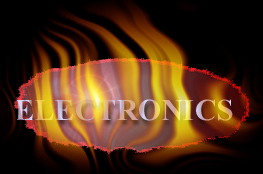

![]()
![]()
Electronic circuits consist of interconnected electronic components. Components are classified into two categories active or passive. Passive components include resistors, capacitors, and inductors. Components considered active include batteries, generators, vacuum tubes, transistors, and amplifiers.

This is the most common component in electronics. It is used mainly to control current and voltage within the circuit. You can identify a simple resistor by its simple cigar shape with a wire lead coming out of each end. It uses a system of color coded bands to identify the value of the component (measured in Ohms). A surface mount resistor is in fact mere millimeters in size but performs the same function as its bigger brother, the simple resistor. A potentiometer is a variable resistor. It lets you vary the resistance with a dial or sliding control in order to alter current or voltage on the fly. This is opposed to the "fixed" simple resistors.COLOR-CODES.

Capacitors, or "caps", vary in size and shape - from a small surface mount model up to a huge electric motor cap the size of a paint can. Whatever the size or shape, the purpose is the same - It storages electrical energy in the form of electrostatic charge. We will get into the mechanics and further properties of this later. The size of a capacitor generally determines how much charge it can store. A small surface mount or ceramic cap will only hold a minuscule charge. A cylindrical electrolytic cap will store a much larger charge. Some of the large electrolytic caps can store enough charge to kill a person. Another type, called Tantalum Capacitors, store a larger charge in a smaller package.
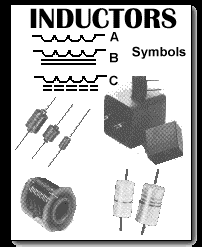
You may remember from science class that adding electrical current to a coil of wire produces a magnetic field around itself. This is how the inductor works. It is charged with a magnetic field and when that field collapses it produces current in the opposite direction. Inductors are used in Alternating Current circuits to oppose changes in the existing current. The mechanics of this will be described later. Most inductors can be identified by the "coil" appearance. Others actually look like a resistor but are usually green in color.

Diodes are basically a one-way valve for electrical current. They let it flow in one direction (from positive to negative) and not in the other direction. Most diodes are similar in appearance to a resistor and will have a painted line on one end showing the direction or flow (white side is negative). If the negative side is on the negative end of the circuit, current will flow. If the negative is on the positive side of the circuit no current will flow. More on diodes in later sections.
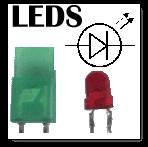

LEDs are simply diodes that emit light of one form or another. They are used as indicator devices. Example: LED lit equals machine on. They come in several sizes and colors. Some even emit Infrared Light which cannot be seen by the human eye.
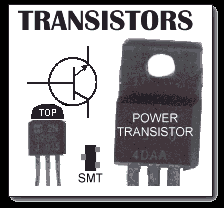
The transistor is possibly the most important invention of this decade. I performs two basic functions. 1) It acts as a switch turning current on and off. 2) It acts as a amplifier. This makes an output signal that is a magnified version of the input signal. More on transistors in later sections. Transistors come in several sizes depending on their application. It can be a big power transistor such as is used in power applifiers in your stereo, down to a surface mount (SMT) and even down to .5 microns wide such as in a microprocessor or Integrated Circuit.

Integrated Circuits, or ICs, are complex circuits inside one simple package. Silicon and metals are used to simulate resistors, capacitors, transistors, etc. It is a space saving miracle. These components come in a wide variety of packages and sizes. You can tell them by their "monolithic shape" that has a ton of "pins" coming out of them. Their applications are as varied as their packages. It can be a simple timer, to a complex logic circuit, or even a microcontroller (microprocessor with a few added functions) with erasable memory built inside.
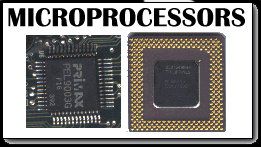
Microprocessors and other large scale ICs are very complex ICs. At their core is the transistor which provides the logic for computers, cars, TVs and just about everything else electronic. Packages are becoming smaller and smaller as companies are learning new tricks to make the transistors ever tinier.
![]()
![]()